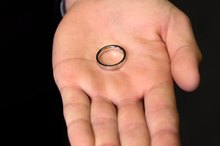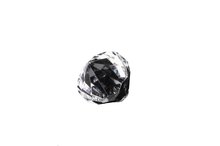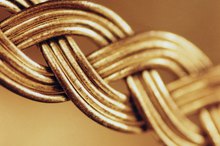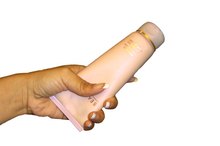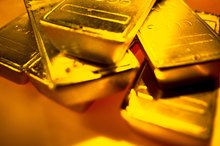Why Does Gold Turn Your Skin Black?
Biological Reason Gold Can Turn Skin Black
Gold is a soft, inert, elementary metal. This means it rarely reacts with other elements or living tissue. However, it can still happen. Gold used for jewelry is not pure. Pure gold is so soft that one could mold it like clay in one's hands. As a result, base metals are often mixed with gold when it is used for jewelry in order to harden it. The degree of gold's purity is determined by karats. Essentially, a karat is a fraction, divided up into 24ths. For example, a 10-karat gold ring is 10/24 gold, the rest being made up of base metals. Jewelry made from 14-karat gold is as close to pure as functionally possible, though some decorative pieces not meant to be worn are even more pure. If gold in excess of 14 karats causes black or dark green marks on the skin, there is only one reason: an iron deficiency. If a person has an iron deficiency, the hemoglobin in the blood is less able to carry oxygen. Iron is not all that dissimilar from gold, chemically speaking. If a person with an iron deficiency wears gold consistently, a black or dark green mark will form over the area where the gold touches the skin. The process by which this happens is not fully explained, but it's theorized that the hemoglobin in the blood migrates toward the gold, causing bursting of minor blood vessels in the affected skin, creating a black or dark green bruise-like color.
- Gold is a soft, inert, elementary metal.
- If gold in excess of 14 karats causes black or dark green marks on the skin, there is only one reason: an iron deficiency.
Gold and Nickel
What Causes Skin Discoloration From Gold?
Learn More
In gold lower than 14 karats, a common metal included in the mix is nickel. It's easily worked and helps the gold to retain its shape. However, it is more chemically active than gold is. If nickel from a piece of gold comes into contact with foundation makeup, it will create a black mark where it touched. Also, many people have a mild allergy to nickel, creating a dark, bruise-like rash over the affected area of the skin.
- In gold lower than 14 karats, a common metal included in the mix is nickel.
- If nickel from a piece of gold comes into contact with foundation makeup, it will create a black mark where it touched.
Gold and Copper
Copper is another common metal included in impure gold. It is not chemically active, but it does oxidize easily. If a piece of gold jewelry is worn consistently in hot, wet or sweaty conditions, the copper in it will begin to oxidize or corrode. This results in a dark green stain on the skin.
- Copper is another common metal included in impure gold.
- If a piece of gold jewelry is worn consistently in hot, wet or sweaty conditions, the copper in it will begin to oxidize or corrode.
Related Articles
References
- Clark P, Tugwell P, Bennet K, et al. Injectable gold for rheumatoid arthritis. Cochrane Database Syst Rev. 2000;1997(2):CD000520. doi:10.1002/14651858.CD000520
- Johns Hopkins Arthritis Center. Rheumatoid Arthritis Treatment: Gold.
- University of Washington Medicine. Gold treatment.
- Joshi P, Dhaneshwar SS. An update on disease modifying antirheumatic drugs. Inflamm Allergy Drug Targets. 2014;13(4):249-61. doi: 10.2174/187152811304140915152102
- Singh JA, Saag KG, Bridges SL Jr, et al. 2015 American College of Rheumatology Guideline for the Treatment of Rheumatoid Arthritis. Arthritis Rheumatol. 2016;68(1):1-26. doi:10.1002/art.39480
- Klinkhoff A. Major side effects of gold therapy. UpToDate.
- Mayo Clinic. Nickel allergy.
- Drug Shortage Canada. Drug Shortage Report for MYOCHRYSINE. Updated June 10, 2020.
- U.S. National Library of Medicine: MedlinePlus. Auranofin. Updated June 24, 2020.
- Mayo Clinic. Gold compound (oral route, parenteral route). Updated February 1, 2020.
Writer Bio
John Albers has been a freelance writer since 2007. He's successfully published articles in the "American Psychological Association Journal" and online at Garden Guides, Title Goes Here, Mindflights Magazine and many others. He's currently expanding into creative writing and quickly gaining ground. John holds dual Bachelor of Arts degrees from the University of Central Florida in English literature and psychology.
